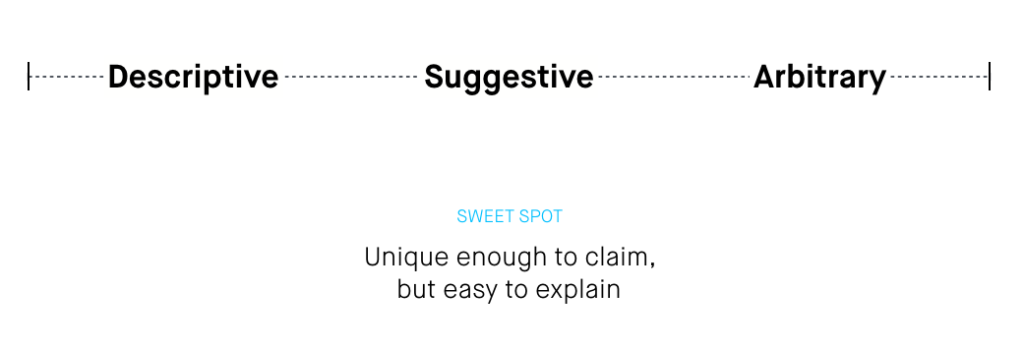Company naming: What approach should you take?
Brand names are everywhere.
Here, I’ll show you. Look down at your desk and see how many names you can find peeking back up at you. I spot at least five: Apple, Moleskine, HydroFlask, Sharpie, Burt’s Bees. When’s the last time you thought about those names? Dissected them? Questioned what feelings they evoke? Tried to figure out what their deal is and how they came to be?
Brand names become such an innate part of our day-to-day that many of us don’t pause to think about the verbal identities of the companies, products, and services we interact with on a regular basis. But when it comes to naming your own business, the importance of having a good name comes into sharp focus. It’s no small task—but it can be made a little easier with a disciplined structure and an understanding of the naming ecosystem.
While some brilliant brand names do bubble to surface on their own accord, oftentimes “the greats” are unearthed through a process of tireless exploration and iteration. We have our own naming process here at New Kind—used to discover, refine, align, and vet names to be sure they are built on a solid (and legally viable) foundation. Today, we’re going to focus on the basics—starting with the three categories of names you should familiarize yourself with and start to recognize out in the real world.
The naming spectrum
Every name falls along what the U.S. Patent & Trademark Office (USPTO) calls the spectrum of distinctiveness. This spectrum helps lawmakers organize trademarks (i.e., company names) into distinct groups that receive varying levels of legal protection.
For our purposes, this spectrum serves as a useful guide to help us brainstorm and organize our potential name candidates. Combined with other considerations (that we’ll get into once you have the basics down pat), knowing where your name falls on the spectrum can help ensure you’re comparing apples to apples when you’re evaluating all of your options together. So fear not the legal jargon!
Back to that spectrum. Here at New Kind, we find that a slightly simplified version does the trick.
Most brand names can be easily plotted somewhere along the scale between descriptive, suggestive, and arbitrary. Let’s take a look at each in more detail.
Descriptive names
Descriptive names borrow meaning directly from what the company does—or the goods or services they offer, aka calling a duck, a duck.
Descriptive names are the most literal of naming options and typically don’t require much explanation. Take the Bankers Box brand, for example. They quite literally make bankers’ boxes and document storage solutions. While descriptive names do the heavy lifting for you by explaining themselves with very little to no additional context necessary, they can also come with a considerable set of limitations.
PROS
- They describe themselves so you don’t need to spend time or resources explaining the brand.
- They have the potential, over time, to take on meaning all on their own (called secondary meaning). This is when consumers start to associate your brand name with the product itself—kind of like how Chapstick has become synonymous with lip balm in tube form, even if the product isn’t actually produced by the Chapstick brand.
CONS
- When it comes to trademarking, they are extremely difficult to own. So much so that they are only eligible for legal protection after they have developed secondary meaning.
- They don’t inspire consumers—or give them a reason to pay attention to you.
- They leave the door wide open for competitors to join the party.
- They are likely to disappear into a sea of sameness.
Arbitrary names
On the other end of the spectrum, there are arbitrary names. These are names that you must work to build meaning into over time.
Arbitrary names can either be real words that are used out of context or invented words that don’t mean anything to the layman—that is, until you’ve created a story behind them. While arbitrary names require a greater upfront investment of time, energy, and money to get off the ground, they are generally easier to protect and own from a legal and SEO standpoint. They are vessels for whatever meaning you want to pour into them, which means you’d better be prepared to devote the resources necessary to turn unfamiliarity into association (and ultimately, loyalty).
PROS
- They are highly unique and differentiated, which means you’ll stand out (aka you don’t have to share).
- They have the potential to mean whatever you want them to mean.
CONS
- They need a lot of love—you’ll need patience, energy, and oftentimes a substantial amount of money to build clout and meaning.
- They ask your customers to take a big mental leap from what you actually do to the name you’ve chosen.
- They might not inherently convey what they should “look” like—so you’ll likely spend more time trying to define their visual language.
Suggestive names
Suggestive names are the “sweet spot” we shoot for here at New Kind—and they look different for every brand we work with. These are names that are unique enough to claim but easy to explain.
Suggestive names require just the right amount of imagination to get from the word itself to the meaning you want to build, but in doing so they bring audiences along on the journey. They invite us to create our own associations with the word by hinting at, rather than dictating, its meaning. They also engage audiences better than descriptive or arbitrary names can; suggestive names immediately create affinity by encouraging people to form their own mental and emotional connections to the name. Particularly in highly saturated markets and industries, suggestive names help companies stand apart by being simultaneously explicative and creative.
Suggestive names give you the best of both worlds
They strike a healthy (and highly marketable) balance between distinctiveness and descriptiveness. They carry their own weight by hinting at what the brand does while still being distanced enough from the technicality of your products or services to ask consumers to exercise their imagination a bit. The leap from awareness to loyalty is shortened just enough so that the name feels immediately familiar—almost delightfully obvious—without being obnoxiously literal.
Suggestive names are also inherently easier to balance in terms of marketability and protectability. While descriptive names require little effort to define, they are near-impossible to own. And while arbitrary names demand copious amounts of education and explanation, they are far easier to trademark. Suggestive names give you room for ownership AND opportunity for affinity. Win-win!
Brands that are doing it right
Now that we’ve learned the ins-and-outs of the spectrum of distinctiveness, let’s take a look at a few brands that are doing this whole naming thing right. We’ll examine three different company names—one from each category—and dissect what their names (and the work they’ve put into them) have helped them achieve.
United Parcel Service (UPS)
A descriptive name that tells it as it is.
UPS (United Parcel Service) takes its name from exactly what the company does: deliver parcels. According to the UPS website, when it came to naming the company, “the word ‘United’ served as a reminder that the company’s operations in each city were part of the same organization, ‘Parcel’ identified the nature of the business, [and] ‘Service’ indicated what was offered.” It’s a package delivery service calling itself a package delivery service.
Despite its relatively unimaginative lexicon, the UPS brand has survived and thrived for well over 100 years. Thanks to the brand’s earned secondary meaning, many consumers now automatically associate the company name (UPS) with the service they provide (package delivery)—even when the service itself isn’t exclusively provided by UPS alone. Once a person learns what the “UPS” acronym stands for, there’s no further question of what the company does.
The name says it all, plain and simple.
Apple
An arbitrary name that filled itself with robust meaning.
It is said that the name, Apple, was purely happenstance. According to co-founder Steve Wozniak, fellow co-founder Steve Jobs had been spending time in the orchards in Oregon at the time they founded the company. They couldn’t think of anything else besides “Apple,” so the name stuck. Another theory is that the founders took inspiration from the apple that purportedly fell on Sir Isaac Newton’s head—a story that lends itself easily to Apple’s first (albeit short-lived) logo.
40+ years after Apple’s founding, we now universally associate the name Apple with a leading technology brand. And this is all thanks to the meaning Apple has built into their brand—their vision, values, beliefs. Before capital-A-Apple, “apple” meant juicy, usually red or green, healthy, fruit. But now, the word Apple is synonymous with very different set of descriptors. It’s sleek, people-centric, democratizing, approachable, and refreshingly simple. What started as an empty vessel has since turned into a brand with a cult-like following, all thanks to the work (and marketing dollars) that went into building its image and verbal identity.
Apple proves that your work isn’t done after you pick a name—it’s the effort that comes later that makes you.
Patagonia
A suggestive name that’s synonymous with adventure and preservation.
Patagonia was never destined to be named after its founder, Yvon Chouinard—and just as well. After carving out the niche they were seeking to fill in outdoor enthusiasts’ lives, and after realizing that attaching their brand to their founder’s name might limit their audience, Patagonia was born. Evoking “romantic visions of glaciers tumbling into fjords, jagged windswept peaks, gauchos and condors,” today the Patagonia brand is synonymous with a certain lifestyle grounded in an appreciation for the outdoors.
Patagonia’s name doesn’t explicitly denote what Patagonia does, nor does it directly relate to the products they produce (they aren’t just selling clothes made in the country of Patagonia). But it does elicit strong mental images that align with the brand’s mission to “build the best product, cause no unnecessary harm, use business to inspire[,] and implement solutions to the environmental crisis.” Its name challenges consumers to visualize the environment in which Patagonia products thrive—and it inspires consumers to explore, venture, activate. It’s not a far leap from “Patagonia” to “outdoor equipment and apparel” to imagery of the beautiful places Patagonia seeks to help preserve.
The associations that Patagonia has built are stronger than the name alone, and their loyal following proves it.
Congratulations! You’re now well on your way to becoming a company naming trendspotter. Start to take note of the types of names you see from the brands you regularly use or work with. Do you find yourself being drawn to more descriptive or arbitrary names? Does the vagueness of a new brand name pull you in or push you away? All of this information will help you become a better namer—and help you think more critically when you’re assessing the efficacy of your own brand name(s).
Stay tuned for future posts about the art (and science) of product and company naming—sign up for our Latest Insights emails so you’re always in know. In the meantime, do you have a naming project you’d like some help with? Get in touch—we’d love to help.




